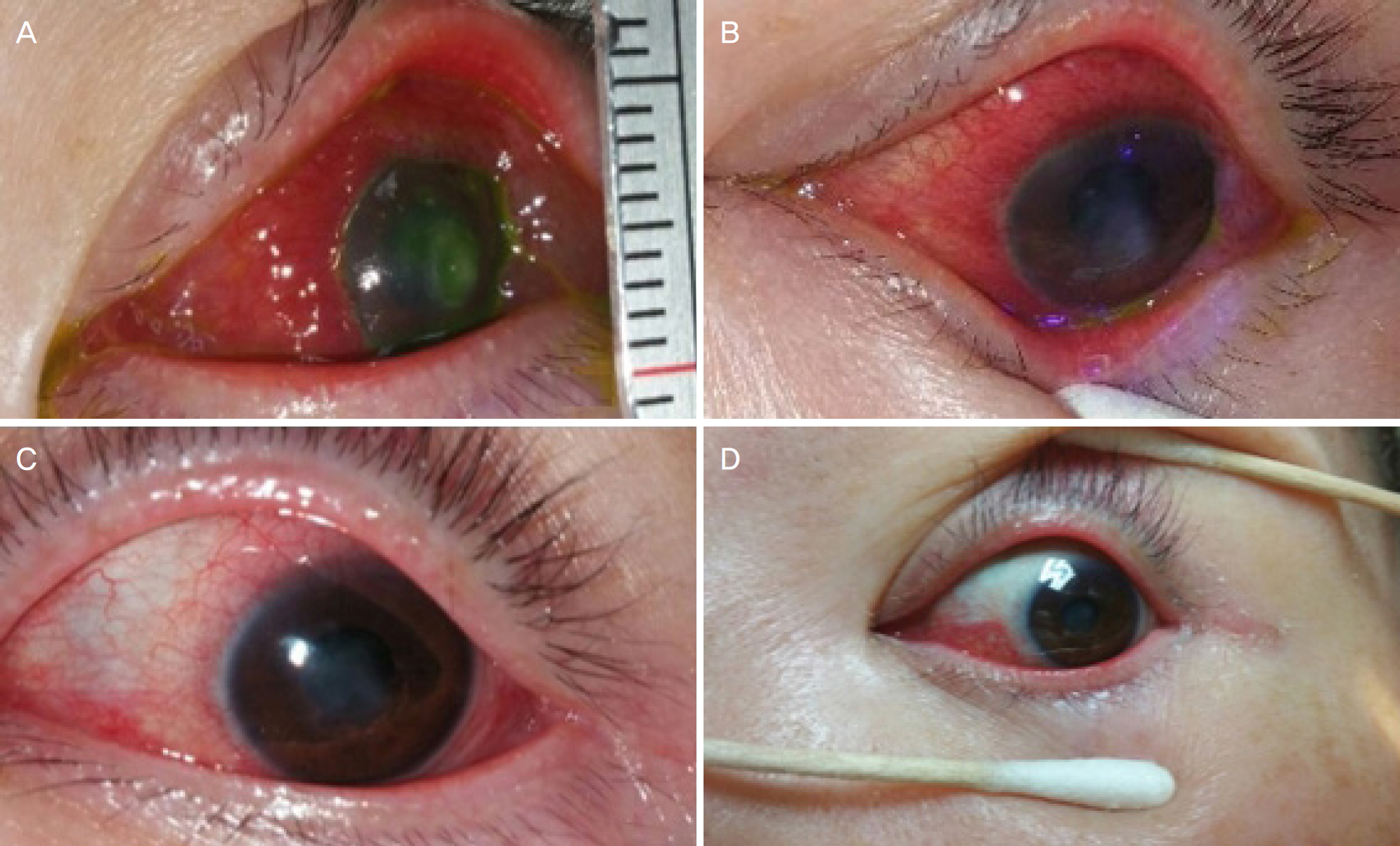J Korean Ophthalmol Soc.
2016 Aug;57(8):1307-1311. 10.3341/jkos.2016.57.8.1307.
A Case of Successful Treatment Using Topical Colistin in Multidrug-resistant Pseudomonas aeruginosa Bacterial Ulcer
- Affiliations
-
- 1Department of Ophthalmology, Ilsan Paik Hospital, Inje University College of Medicine, Goyang, Korea. jhk0924@hanmail.net
- KMID: 2349081
- DOI: http://doi.org/10.3341/jkos.2016.57.8.1307
Abstract
- PURPOSE
To report a successful case of corneal ulcer caused by multidrug-resistant Pseudomonas aeruginosa using topical colistin in an immobilized patient who was hospitalized for a long period.
CASE SUMMARY
An immobilized 58-year-old female who was admitted for a long stay due to cerebral aneurysm hemorrhage presented with left ocular discharge and hyperemia, and was referred to our clinic. The patient was treated at a local clinic with topical antibiotics, but showed no improvement. At initial visit, she had difficulty communicating with the medical team and taking ophthalmic examination, and she had severe chemosis and corneal infiltration, corneal opacity, and hypopyon on her left eye with a portable slit lamp. Gram staining, bacterial and fungal cultures, and an antibiotic sensitivity test were performed from a corneal scrape. The cultures revealed growth of Pseudomonas aeruginosa, which is resistant to all antibiotics except colistin. As soon as we were aware of the results of the antibiotic sensitivity test, she was treated with topical colistin 0.19% every 1 hour on her left eye, starting immediately. After 28 days of treatment, the infection was resolved except for the remaining corneal opacity. She had a persisted stable corneal lesion at 1-year-follow up after colistin treatment, which indicated no recurrence.
CONCLUSIONS
Due to gait disturbance, the patient almost missed appropriate ophthalmic examination or treatment. However, as we started immediate topical colistin treatment, we report a successful therapy of corneal ulcer induced by multidrug-resistant Pseudomonas aeruginosa without severe complications, such as perforation.
MeSH Terms
Figure
Reference
-
References
1. Park JY, Suh ES. A case of tectonic lamellar corneal patch graft abdominal acellular cornea in corneal ulcer perforation. J Korean abdominal Soc. 2015; 56:1278–83.2. Hahn YH, Hahn TW, Choi SH, et al. Epidemiology of infectious keratitis [I] a abdominal study. J Korean Ophthalmol Soc. 1998; 39:1633–51.3. Hyon JY, Sinha D, O'Brien TP, et al. Expression of IRFs and iNOS in the mouse cornea with Pseudomonas aeruginosa keratitis. J Korean Ophthalmol Soc. 2006; 47:1654–61.4. Cho EY, Lee SB. Gram-negative bacterial keratitis: a 15-year abdominal of clinical aspects. J Korean Ophthalmol Soc. 2015; 56:1479–88.5. Vazirani J, Wurity S, Ali MH. Multidrug-resistant Pseudomonas aeruginosa keratitis: risk factors, clinical characteristics, and abdominals. Ophthalmology. 2015; 122:2110–4.6. Jain R, Murthy SI, Motukupally SR. Clinical outcomes of corneal graft infections caused by multi-drug resistant Pseudomonas aeruginosa. Cornea. 2014; 33:22–6.
Article7. Whitcher JP, Srinivasan M, Upadhyay MP. Corneal blindness: a global perspective. Bull World Health Organ. 2001; 79:214–21.8. Sy A, Srinivasan M, Mascarenhas J, et al. Pseudomonas abdominal keratitis: outcomes and response to corticosteroid treatment. Invest Ophthalmol Vis Sci. 2012; 53:267–72.9. Aloush V, Navon-Venezia S, Seigman-Igra Y, et al. Multidrug-re-sistant Pseudomonas aeruginosa: risk factors and clinical impact. Antimicrob Agents Chemother. 2006; 50:43–8.10. Jain R, Murthy SI, Motukupally SR, Jain M. Use of topical colistin in multiple drug-resistant Pseudomonas aeruginosa bacterial abdominal. Cornea. 2014; 33:923–7.11. Tajima K, Miyake T, Koike N, et al. In vivo challenging of poly-myxins and levofloxacin eye drop against multidrug-resistant Pseudomonas aeruginosa keratitis. J Infect Chemother. 2014; 20:343–9.12. Lund MH. Colistin sulfate ophthalmic in the treatment of ocular infections. Arch Ophthalmol. 1969; 81:4–10.
Article13. Reina R, Estenssoro E, Sáenz G, et al. Safety and efficacy of abdominal in Acinetobacter and Pseudomonas infections: a prospective cohort study. Intensive Care Med. 2005; 31:1058–65.14. Mubareka S, Rubinstein E. Aerosolized colistin for the treatment of nosocomial pneumonia due to multidrug-resistant Gram-neg-ative bacteria in patients without cystic fibrosis. Crit Care. 2005; 9:29–30.15. Michalopoulos A, Kasiakou SK, Rosmarakis ES, Falagas ME. Cure of multidrug-resistant Acinetobacter baumannii bacteraemia with continuous intravenous infusion of colistin. Scand J Infect Dis. 2005; 37:142–5.
Article16. Michalopoulos AS, Tsiodras S, Rellos K, et al. Colistin treatment in patients with ICU-acquired infections caused by multiresistant Gram-negative bacteria: the renaissance of an old antibiotic. Clin Microbiol Infect. 2005; 11:115–21.
Article17. Berlana D, Llop JM, Fort E, et al. Use of colistin in the treatment of multiple-drug-resistant gram-negative infections. Am J Health Syst Pharm. 2005; 62:39–47.
Article
- Full Text Links
- Actions
-
Cited
- CITED
-
- Close
- Share
- Similar articles
-
- Evaluation of the Reliability of Automated Colistin Susceptibility Assays of Pseudomonas aeruginosa
- Susceptibility of Clinical Isolates of Acinetobacter baumannii and Pseudomonas aeruginosa to Colistin and Polymyxin B in Korea
- In Vitro Activity of Antimicrobial Combination against Multidrug-Resistant Pseudomonas aeruginosa, Korea
- Anti-inflammatory and Anti-bacterial Effects of Aloe vera MAP against Multidrug-resistant Bacteria
- Three Cases of Pseudomonas Corneal Ulcer in Soft Contact Lens Wearer



